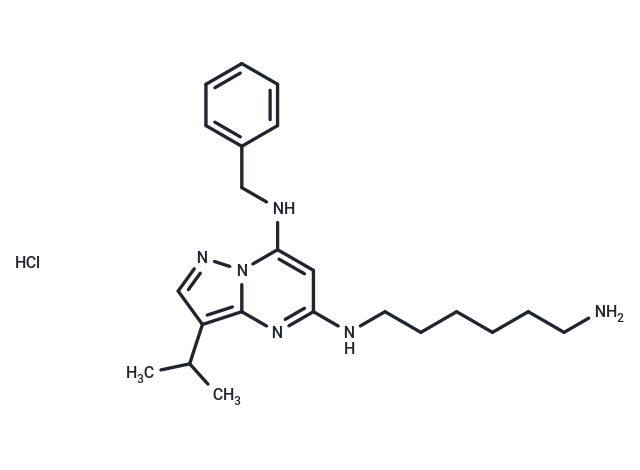Shopping Cart
Remove All Your shopping cart is currently empty
Your shopping cart is currently empty
BS-181 hydrochloride (BS-181 HCl) is a highly selective CDK7 inhibitor with IC50 of 21 nM. It is more than 40-fold selective for CDK7 than CDK1, 2, 4, 5, 6, or 9.

| Pack Size | Price | USA Warehouse | Global Warehouse | Quantity |
|---|---|---|---|---|
| 1 mg | $31 | In Stock | In Stock | |
| 2 mg | $44 | In Stock | In Stock | |
| 5 mg | $72 | In Stock | In Stock | |
| 10 mg | $118 | In Stock | In Stock | |
| 25 mg | $263 | In Stock | In Stock | |
| 50 mg | $438 | In Stock | In Stock | |
| 100 mg | $679 | In Stock | In Stock | |
| 200 mg | $945 | - | In Stock | |
| 1 mL x 10 mM (in DMSO) | $79 | In Stock | In Stock |
| Description | BS-181 hydrochloride (BS-181 HCl) is a highly selective CDK7 inhibitor with IC50 of 21 nM. It is more than 40-fold selective for CDK7 than CDK1, 2, 4, 5, 6, or 9. |
| Targets&IC50 | CDK6-CyclinD1:47 μM, CDK1-CyclinB:8.1 μM, CDK9-CyclinT:4.2 μM, CDK7:21 nM, CDK5-p35 NCK:3 μM, CDK2-CyclinE:0.88 μM, CDK4-CyclinD1:33 μM |
| In vitro | BS-181 is a small molecule inhibitor of CDK7 in a cell-free environment, which displays more potential activity than roscovitine with IC 50 of 510 nM. Among the CDKs and other 69 kinases from many different classes, BS-181 shows high inhibitory selectivity for CDK7, inhibits CDK2 at concentrations lower than 1 μM which being inhibited 35-fold less potently (IC50 with 880 nM) than CDK7, shows slight inhibition for CDK1, CDK4, CDK5, CDK6 and CDK9 with IC50 values higher than 3.0 μM, and only shows inhibition for several kinases from other classes at high concentrations (>10 μM). BS-181 promotes cell cycle arrest and inhibits the cancer cell growth of a range of tumor types, including breast, lung, prostate and colorectal cancer with IC50 in the range of 11.5-37 μM. In MCF-7 cells, BS-181 inhibits the phosphorylation of the CDK7 substrate RNA polymerase II COOH-terminal domain (CTD), and promotes cell cycle arrest and apoptosis to inhibit the growth of cancer cell lines. [1] |
| In vivo | BS-181 is stable in vivo with a plasma elimination half-life in mice of 405 minutes after i.p. administration of 10 mg/kg. BS-181 inhibits the growth of MCF-7 xenografts in the nude mice model in a dose-dependent manner, with 25% and 50% reduction in tumor growth after 2 weeks of treatment at 10 mg/kg/day and 20 mg/kg/day, respectively without apparent toxicity. [1] |
| Kinase Assay | In vitro kinase inhibition.: Inhibition of CDK7 activity is measured by incubation of increasing amounts of BS-181 with purified recombinant CDK7/CycH/MAT1 complex, followed by measurement of free ATP remaining in the reaction using a luciferase assay, luciferase activity therefore providing a measure of inhibition of CDK7 activity for the determination of IC50. |
| Cell Research | MCF-7 cells are exposed to BS-181 for 24 hours. For the determination of cell cycle and apoptosis, cells are stained with propidium iodide or labeled with Annexin V-FITC, then labeled cells are acquired within 1 hour, by using the RXP cytomics software on a Beckman Coulter Elite ESP, and the data are analyzed using Flow Jo v7.2.5. For the assessment of CDKs, cells are lysed and analyzed by western blotting.(Only for Reference) |
| Synonyms | BS-181 HCl |
| Molecular Weight | 416.99 |
| Formula | C22H32N6·HCl |
| Cas No. | 1397219-81-6 |
| Smiles | Cl.CC(C)c1cnn2c(NCc3ccccc3)cc(NCCCCCCN)nc12 |
| Relative Density. | no data available |
| Color | Purple |
| Appearance | Solid |
| Storage | Powder: -20°C for 3 years | In solvent: -80°C for 1 year | Shipping with blue ice/Shipping at ambient temperature. | ||||||||||||||||||||||||||||||||||||||||
| Solubility Information | Ethanol: 22 mg/mL (52.76 mM), Heating is recommended. H2O: 50 mg/mL (119.91 mM), Sonication is recommended. DMSO: 100 mg/mL (239.81 mM), Sonication is recommended. | ||||||||||||||||||||||||||||||||||||||||
| In Vivo Formulation | 10% DMSO+40% PEG300+5% Tween 80+45% Saline: 4 mg/mL (9.59 mM), Sonication is recommended. Please add the solvents sequentially, clarifying the solution as much as possible before adding the next one. Dissolve by heating and/or sonication if necessary. Working solution is recommended to be prepared and used immediately. The formulation provided above is for reference purposes only. In vivo formulations may vary and should be modified based on specific experimental conditions. | ||||||||||||||||||||||||||||||||||||||||
Solution Preparation Table | |||||||||||||||||||||||||||||||||||||||||
Ethanol/H2O/DMSO
H2O/DMSO
| |||||||||||||||||||||||||||||||||||||||||
| Size | Quantity | Unit Price | Amount | Operation |
|---|

Copyright © 2015-2025 TargetMol Chemicals Inc. All Rights Reserved.